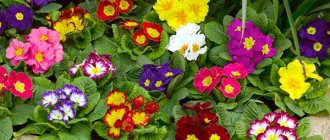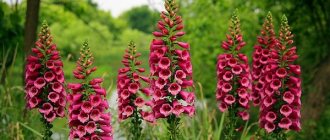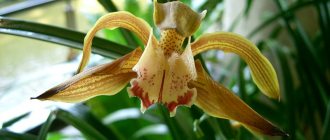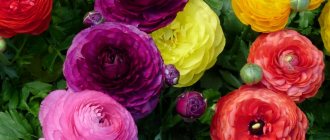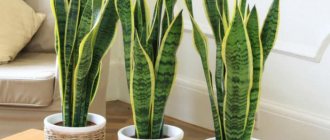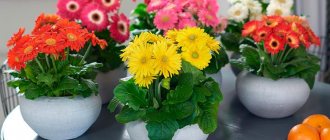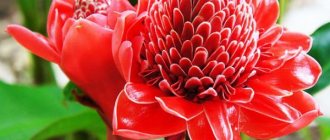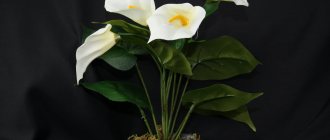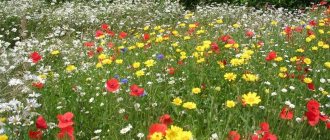Hydrangea is an airy flower with multi-colored “caps”
When you see hydrangea, you get a feeling of lightness and airiness. Looking at these flowers, you just want to pick a fluffy bouquet of multi-colored flowers or plant whole rows of them so that their multi-colored “caps” are on both sides of the path. The hydrangea plant belongs to the genus Hydrangeaceae. Among its species there are trees with simple leaves or shrubs. Hydrangea can also be liana-shaped. The flowers are small in size, collected in spherical inflorescences, no aroma. However, these inflorescences themselves immediately catch the eye. They give the plant a decorative appearance.
Interesting: hydrangea not only has a beautiful appearance. She is also healing!
Planting hydrangea
This plant should be planted in early spring or autumn. When the climate is cold, it is recommended to plant young hydrangeas from cuttings in the spring to better withstand frosts in the next winter. Before planting, it is necessary to add organic and mineral fertilizers to the soil and prepare a hole in which to pour peat. Don't forget that this plant needs to shorten its roots.
The plant is most often planted singly, sometimes in groups on the lawn. The planting hole should have dimensions of 30x30x30 cm, the distance from one hydrangea to another should be about one meter. When planting, you should not bury the root collar. In the spring, during planting, annual shoots should be shortened by three or four buds. The bush that has been planted must be well watered and covered with peat or humus.
Hydrangea propagation
- Dividing the bush
The bush is divided both in spring and autumn. To do this, the plant is dug up, then divided into a number of bushes so that the division contains a renewal bud. Then the bush is planted in the prepared place.
Cuttings are usually harvested in April. To do this, take green twigs from the crown and cut them at right angles. Afterwards they are planted in a fertile extract. When rooting has occurred, they are planted in a growing bed. The plant will grow in it for 1-2 years, after which it is transplanted to a permanent place outside.
In the first year after planting, the plant should be covered for the winter, and the flowers should be picked off from young cuttings. Cuttings in winter are allowed only for large-leaved hydrangea. To do this, in mid-autumn you should dig up the parent plant and plant it in a pot at home. The temperature should be 0+2 °C. And at the beginning of winter, the temperature for growing should be +7-10 °C. The plant must be replanted in soil made from humus, sand, peat, turf soil (2:1:1:4). February is the time when the plant comes to life and begins to grow. After this, you need to cut the green cuttings and root them in a pot of nutritious soil. The leaves should be shortened by 2 times.
It is necessary to bend the shoots to the ground (they must be no older than one year), leaving the top of the shoot 20 cm long outside. In the fall or early spring of next year, the shoot that has taken root must be separated and replanted.
Hydrangea is rarely propagated by grafting and seeds.
Hydrangea care
- Introduction of fertilizing from mineral and organic fertilizers (you need to fertilize in moderation, because voluminous inflorescences can bend the branches of the bush).
- Watering. It is recommended that the acidity of water for irrigation not exceed 5.6 pH. This plant loves moisture and should not be allowed to dry out.
- Loosen the soil three times per season to a depth of 5-10 cm.
How does pruning happen?
- In large plants, the inflorescences that have bloomed are cut off in the fall.
- Young bushes are pruned in the spring, before buds appear. In order for the plant to be as lush as possible and to be able to survive the winter, the young shoots of the bush are pruned to four buds.
- If you deliberately prune the cuttings over a period of 4-5 years, you will get an excellent small hydrangea tree.
- In the first year of flowering cuttings, you need to pick off the flowers. This will help the bush gain more strength to bloom beautifully next season.
Change in color of hydrangeas
New varieties of hydrangeas and large-leaved species can change the color of the flowers. To do this, you need to use different dyes, which can be bought at a store specializing in fertilizers. If you want your hydrangea to acquire a blue tint, you need to use iron or aluminum crystals when watering twice a week. Aluminum sulfate will also work. If you want hydrangea to bloom with pink inflorescences in the garden, then you need to use a solution of potassium permanganate. Peat can also affect the color of hydrangeas. You need to water the plant with peat infusion - change the color of the hydrangea, add excellent fertilizer for the soil and roots of the plant.
Sheltering the plant for the winter
It is better if the shelter for the winter is horizontal. This way you will preserve the flower buds that form on the branches of the plant. This way the plant will bloom early.
What types of hydrangea are there?
There are many types of hydrangea. There are species that suffer from intense heat, and there are also those that like to grow in partial shade. There are also types of hydrangea that prefer to grow under the rays of the hot sun. Therefore, we will consider those types of hydrangea that best take root and grow in our country.
Hydnopa africana
An amazing plant with an unusual shape. African Hydnora is called an “alien flower.” However, it bears little resemblance to a plant. Grows in deserts in southern Africa, Arabia and the island of Madagascar. Outwardly it resembles a mushroom, exactly until the flower blooms - an open mouth. The inside is painted bright orange.
African Gidnora smells disgusting - like rotten meat. This plant is a parasite; it attracts the attention of insects and feeds on them. All “neighbors” of the Hydnors are doomed to certain death. It sucks moisture from plants that grow nearby, due to which it continues to exist.
Garden flowers names and photos
One of the main elements of any garden are flowers. They make it beautiful, bright and memorable. Their variety is so great that making a choice sometimes becomes very difficult.
This page is about garden flowers - a catalog with photographs and names , as well as a description of the planting and flowering period of these plants. You can also familiarize yourself with the catalog of indoor plants. We’ll start with how to use the garden flower catalog to choose the best specimens for your site.
Rafflesia Arnolda
Plant parasite. Distributed on the islands of Sumatra and Kalimantan. Most species of Rafflesia Arnold are in danger of extinction. The plant is the leader in flower diameter - up to 100 cm. The maximum weight is 8 kg.
Finding Rafflesia is not easy; in the jungle they grow singly, bloom unevenly, and the flowering period lasts only 4 days. The flowers are quite massive, red-brown in color, with a specific smell that attracts flies. The bud ripens for several months.
Recently, Rafflesia Arnolda has attracted the attention of cosmetic companies. The reason is essential oils, which have unique properties: cleanse the skin and smooth out wrinkles.
1 1
Selecting from a catalog of garden flowers for your garden
Location is the main criterion that is responsible for the life and active development of plants. If you plant light-loving flowers in a dark place, then they will not be able to delight their owners with their beauty for a long time. This means you need to know in advance the insolation in your own area and the attitude of your favorite plants to light. Therefore, before selecting plants, decide which area you want to plant with garden flowers. After this selection, you can move on to the next point.
Features of flowers. According to morphology, flowers are divided into annual (marigolds, petunias) and perennial (hostas, daisies, lilies). The difference lies in the different periods of their life and development. The first type is cheaper, but it grows only one year; the next year it is necessary to purchase plant material again. Using the catalog search form, you can sort flowers by life expectancy. Perennial plants can be planted only once, and they will delight their owners every year. The second type is more expensive than the first.
Victoria amazonica
Tropical plant of the Water Lily family. The national flower of Guyana, the most popular greenhouse plant. Distributed in Guyana, Brazil (Amazon River), Bolivia.
Victoria Amazoniana blooms only two or three days a year. They open in turn, can reach 30 cm in diameter, each inflorescence contains up to 60 petals. The leaves of this “giant water lily” are very large (diameter up to 2 m).
Blooming Victoria Amazonis is a fascinating process. It blooms in the late afternoon, revealing its soft white petals. The next day it plunges under water, and in the afternoon it rises again. At this time, the color changes (from light pink to dark purple), after which the flowers finally go under water.
List of colors alphabetically from a to z
Flower names in alphabetical order by letter
- Radermacher
- Broom
- Rhubarb
- Reo, tradescantia reo
- Rhipsalidopsis, Easter cactus
- Robinia, Acacia
- Rogersia
- Rhodiola
- Rhododendron
- Rose, rosehip
- Roycissus
- Sundew
- Rudbeckia
- Rousselia, coral plant
- Ruellia
- Rowan
- Fieldfare
- Hazel grouse, fritillaria
- Cycad, Cycas
- Salpiglossis
- Boxwood
- Sanvitalia
- Sansevieria, pike tail, mother-in-law's tongue
- Sarracenia
- Safflower
- Plumbago
- Selaginella, the resurrection plant
- Saintpaulia, Usambara violet
- Setcreasia
- Sidalcea
- Siderasis
- Syngonium
- Feverweed
- Sinningia, Gloxinia
- Sinyukha, polemonium
- Lilac
- Sitnik
- Scabiosa, widow, bark bark
- Skimmia
- Scopolia
- Mackerel, yellowberry
- Plum, Prunus
- Smilatsina
- Currant
- Snowberry
- Snooze
- Saltirolia, Gelksina, Helksina
- Solnechnik, Heliopsis
- Sunflower
- Sorbocotoneaster
- Pine
- Sophora
- Sparmannia, indoor linden
- Spathiphyllum
- Spiraea, meadowsweet
- Sprekelia, sprekelia
- Stapelia
- Stahis
- Stefanandra
- Stephanotis, Madagascar jasmine
- Ostrich - fern
- Strelitzia, bird of paradise
- Arrowhead
- Streptocarpus, stemmed violet
- Strobilanthes
- Stromanta
- Sumac
- Sutera, bacopa
- Schizanthus, schizanthus
- Scaevola
- Scindapsus, Epipremnum
- Scirpus
- Tobacco
- Takka, bat
- Tamarix, comber
- Tetrastigma
- Tiarella, tiarka
- Tillandsia, Spanish, Louisiana moss
- Thyme, thyme
- Tiss
- Tithonia
- Tladianta
- Tolmia
- Bearberry
- Thick-walled
- Crassula, crassula, money tree
- Torenia
- Tradescantia
- Trillium
- Tritsirtis
- Thunbergia
- Thuja
- Pumpkin
- Yarrow
- Tulip
- Uvularia
- Phalaenopsis - orchid
- Fatsia, Aralia
- Fatshedera
- Violet, viola
- Physalis, flashlight
- Physostegia
- Ficus
- Philodendron
- Date fruit
- Fittonia
- Phlox
- Forsythia
- Fortunella, kincan, kumquat
- Phragmipedium - orchid
- Fuchsia
- Haworthia
- Hakonechloa
- Hamedorea
- Chamelacium, wax myrtle
- Hathiora
- Houttuinia, huttinia, houtinia
- Hebe
- Helona
- Chaenomeles, Japanese quince
- Hirita
- Chlorophytum
- Hop
- Hovea, Kentia
- Hoya
- Hosta, funkia
- Corydalis
- Chrysanthemum
- Chrysanthemum, dendranthemum
- Ceanothus, Redroot
- Coelogina - orchid
- Celosia
- Celosia
- Cereus
- Ceropegia
- Tsercis
- Cyanotis
- Cyclamen
- Cyclamen, dryweed, alpine violet
- Cymbidium - orchid
- Cohosh
- Cineraria
- Zinnia
- Cyperus, satiate
- Cissus, indoor ivy, birch
- Citrus
- Bird cherry
- Blueberry
- Chernogolovka, prunella
- Chokeberry, chokeberry
- China, sweet pea
- Mock orange, garden jasmine
- Sage
- Mulberry, Here
- Scheffler
- Rose stock, mallow, mallow, alcea
- Setaria, bristlecone
- Shield plant, dryopteris - fern
- Eucalyptus
- Edelweiss
- Eichornia, water hyacinth
- Exakum
- Endymion
- Evening primrose, night candle, aspen tree
- Aeonium
- Epipremnum
- Episcia
- Epiphyllum
- Eremurus, shiryash
- Erika
- Eschynanthus
- Eucomis, eucomis
- Eustoma, lisianthus, Japanese rose
- Eucharis, Amazon lily
- Echeveria
- Echinocactus, hedgehog cactus
- Ekhmeya
- Eschszolzia
- Yucca
- Jacobinia
- Yasenets, burning bush
- Yasenets, burning bush
- Cerastium, cerastium
- Woodruff, asperula
- Woodruff, asperula
- Jatropha
Choosing white flowers for the garden
What does white mean? For most, it is a symbol of purity, innocence, joy, happiness, carelessness, and childhood.
And if this color is not entirely practical in everyday life, then why not transfer it to the garden.
Like interior design, landscape design in white colors will allow you to achieve a visual increase in space, lightness, and a feeling of freedom.
Therefore, today we will look at what white flowers there are for the garden, and we will present the main assortment that you can use when creating a flower garden.
Stapelia gigantea
Belongs to the genus of succulents. It grows in South and South-West Africa, but only in areas with a desert climate.
A small perennial plant. The average height is 20 cm, the diameter of the stem is 3 cm. But the inflorescence of Giant Stapelia is impossible not to notice. These are large stars that reach 35 cm in diameter and are pale yellow in color. A very beautiful plant, but the smell is no better than that of African Hydnora. However, there are brave souls who breed stapelia at home.
Selection of an assortment of herbaceous species with white flowers
In the world of plants, white color is not uncommon; you can see it every spring, when fruit trees begin to bloom, and the first flowers - snowdrops - cover the sunny forest glades.
Modern genetics and selection today boast a long list of developed varieties, but how not to get confused in this diversity? After all, flowers with white flowers have different sizes, corolla shapes, number of petals, etc.
Let's divide the species and varieties into three groups - annuals and biennials, perennials and bulbous ones. Many of the names will be familiar, especially to those who have been interested in gardening for a long time, but for beginners this information will be very useful.
Examples of garden design in white
Perhaps someone will say that white landscape design is boring and uninteresting. However, only those who have not seen anything like this in person can think so.
After all, this is not a plain white wall. This is a voluminous composition, where white color effectively combines with green, large flowers contrast with small ones, tall ones with low ones. Only by planting density can you radically change the entire look.
And if, in addition to herbaceous plants, you select shrubs and trees that bloom with white flowers or have white foliage, then such a picture will evoke admiring glances not only from neighbors, but also from friends and relatives.
Here are some examples of successful garden decoration with plants with white flowers. Look how light and clean these compositions look.
Don't be afraid to use just one color in your garden. It will look stylish and modern. The main rule is a harmonious combination of all landscape elements, including buildings, small architectural forms and, of course, plants.
| The size of the plant is very important. If a mixborder is arranged in the garden, then the largest and tallest plants should be planted at the very end, and small and abundantly flowering plants should be planted at the beginning. My catalog of garden flowers contains photographs, thanks to which you can navigate by plant size. All seed packages usually indicate the sizes of interest. If you buy seedlings, it is better to find out all the necessary data from reliable sources. |
Puya Raymond
This plant can be found in Bolivia and Peru, and in the wild only in the Andes. It looks like a tree and is a huge inflorescence up to 10 m high, up to 2.5 m in diameter. Each inflorescence contains up to 10 thousand flowers.
Puya Raymond blooms once in a lifetime; after the seeds ripen, the plant dies. Recently, their numbers have been declining. The countries in which Puya Raymond grows carry out a number of measures to preserve the number of plants.
